Study of the Fire Behavior of Multilayer Cables in a Mine Tunnel
Abstract
:1. Introduction
2. Materials and Methods
2.1. FDS Theoretical Basis
2.2. Physical Model
2.3. Combustion Settings
Fuel Air
1 (HCl + H2O + 0.14 CO + 0.96 CO2 + 0.90 C + 1.53 (3.76) N2)
Products
2.4. Ignition Source
2.5. Other Conditions Settings
2.6. Dividing Mesh
2.7. Feasibility Analysis of Simulation
2.8. Working Conditions
3. Results and Discussion
3.1. Fire Characteristics of a Multilayer Cable
3.2. Heat Release Rate under Different Working Conditions
3.3. The Flame Spread Rate under Different Working Conditions
4. Conclusions
- (1)
- For multilayer cables, cable flames and hot flue gases spread upward under the influence of thermal buoyancy and form a roof jet, leading to a higher temperature closer to the roof. In addition, the burning rate of the upper cables is faster than that of the lower cables, and the fire zone forms a “V” shape. The closer the cables were to the ceiling, the faster the cables burned. Therefore, cables should not be laid too close to the ceiling.
- (2)
- Cable hooks have a noticeable inhibition effect on cable combustion, the hooks hinder air entry. It slows down the rate of spread of the fire when the cable burns to the iron hook. The impact on the upper layer cables is lower than that on the lower layer cables. As the fire develops, this impact gradually diminishes.
- (3)
- Cable tray spacing, ignition position, and wind speed influence the behavior of a multilayer cable fire. These factors change the heat transfer between the cables, the amount of contact with air, and heat accumulation. It was also noted that increasing the spacing or wind speed both made the peak of heat release rate (PHRR) initially increase and then decrease, and affected the combustion of cables initially promoting and then inhibiting. The influence of wind speed on the cable burnout rate in the upstream and downstream sides of fire source was not consistent, and the wind speed had a sensitive effect on the cable burnout rate in the upstream side of the fire source. The ignition position affected the development speed of the cable fire. The higher the ignition position was, the longer the arrival time of PHRR was and the slower the fire developed. Combined with the above factors, when the cable tray spacing is 25 mm, the ignition position is below the fourth layer of cables, the wind speed is 1 m/s, the cable combustion rate is the slowest, the heat release is the smallest, and the fire hazard is the lowest.
Author Contributions
Funding
Conflicts of Interest
References
- Gao, K.; Li, S.; Su, B.; Liu, Y.; Wang, X.; Shi, L. Hole/pore-scale investigation of gas explosions in a coal-mine gob. Process Saf. Environ. Prot. 2021, 156, 531–544. [Google Scholar] [CrossRef]
- Kaczorekchrobak, K.; Fangrat, J. Calorimetric Behaviour of Electric Cables. Energies 2021, 14, 1007. [Google Scholar] [CrossRef]
- Perka, B.; Piwowarski, K. A Method for Determining the Impact of Ambient Temperature on an Electrical Cable during a Fire. Energies 2021, 14, 7260. [Google Scholar] [CrossRef]
- Li, C.; Chen, J.; Zhang, W. Influence of Arc Size on the Ignition and Flame Propagation of Cable Fire. Energies 2021, 14, 5675. [Google Scholar] [CrossRef]
- Wu, Y.J.; Yuan, Q.G.; Song, Z.S. Analysis on Power Cable Firing Accident Cause and Prevention Measures in Underground Mine. Chin. Coal Eng. 2010, 12, 53–54. [Google Scholar]
- Chen, J. Reflection on Mine Electric Cable Fire Accident. Chin. Saf. Coal Mines 2011, 42, 133–134. [Google Scholar]
- Klein, R.A. SFPE handbook of fire protection engineering. Fire Saf. J. 1997, 29, 61–63. [Google Scholar] [CrossRef]
- Tewarson, A.; Khan, M. Fire Propagation Behavior of Electrical Cables. Fire Saf. Sci. 1989, 2, 791–800. [Google Scholar] [CrossRef] [Green Version]
- Tewarson, A.; Khan, M. Flame propagation for polymers in cylindrical configuration and vertical orientation. Symp. Combust. 1989, 22, 1231–1240. [Google Scholar] [CrossRef]
- Nuianzin, O.; Pozdieiev, S.; Hora, V.; Shvydenko, A.; Samchenko, T. Experimental study of temperature mode of a fire in a cable tunnel. Eastern-Eur. J. Enterp. Technol. 2018, 3, 21–27. [Google Scholar] [CrossRef]
- Wang, W.; Li, L.M.; Wan, Y.T. Full scale flame spread test on bundled PVC cables. Chin. Fire Sci. Technol. 2009, 28, 473–478. [Google Scholar]
- Liang, K.; Hao, X.; An, W.G.; Tang, Y.; Cong, Y. Study on cable fire spread and smoke temperature distribution in T-shaped utility tunnel. Case Stud. Therm. Eng. 2019, 14, 100433. [Google Scholar] [CrossRef]
- An, W.G.; Tang, Y.H.; Liang, K.; Cai, M.; Wang, T.; Wang, Z. Study on temperature distribution and CO diffusion induced by cable fire in L-shaped utility tunnel. Sustain. Cities Soc. 2020, 62, 102407. [Google Scholar] [CrossRef]
- An, W.G.; Wang, X.S.; Tang, Y.H.; Wang, T.; Lu, J. Influence of cable inclination angle and longitudinal ventilation on temperature distribution during cable fire in utility tunnel. Case Stud. Therm. Eng. 2021, 27, 101304. [Google Scholar] [CrossRef]
- Plumecocq, W.; Audouin, L.; Zavaleta, P. Horizontal cable tray fire in a well-confined and mechanically ventilated enclosure using a two-zone model. Fire Mater. 2019, 43, 530–542. [Google Scholar] [CrossRef]
- Magalie, C.; Anne-Sophie, C.; Rodolphe, S.; Laurent, F.; Emmanuelle, G.; Christian, L. Fire behaviour of electrical cables in cone calorimeter: Influence of cables structure and layout. Fire Saf. J. 2018, 99, 12–21. [Google Scholar] [CrossRef]
- Effects of interlayer distance and cable spacing on flame characteristics and fire hazard of multilayer cables in utility tunnel—Sciencedirect. Case Stud. Therm. Eng. 2020, 22, 100784. [CrossRef]
- Li, L.; Huang, X.; Bi, K.; Liu, X. An enhanced fire hazard assessment model and validation experiments for vertical cable trays. Nucl. Eng. Des. 2016, 301, 32–38. [Google Scholar] [CrossRef]
- Luo, X.; Huang, X.J.; Kun, B.I.; Liu, X.S.; Jiang, X. On the vertical cable tray combustion in regard to the different cable allocation in the open and wrapped-up space. J. Saf. Environ. 2017, 17, 975–979. [Google Scholar]
- Wu, T.Q.; Huang, X.J.; Kun, B.I.; Liu, X.S.; Jiang, X. Experimental and numerically simulated study on the fires in the horizontally arranged multilayer cable trays. J. Saf. Environ. 2016, 16, 69–74. [Google Scholar]
- Hu, L.; Fong, N.; Yang, L.; Chow, W.; Li, Y.; Huo, R. Modeling fire-induced smoke spread and carbon monoxide transportation in a long channel: Fire dynamics simulator comparisons with measured data. Hazard. Mater. 2007, 140, 293–298. [Google Scholar] [CrossRef] [PubMed]
- Hu, L.; Huo, R.; Wang, H.; Yang, R. Experimental and numerical studies on longitudinal smoke temperature distribution upstream and downstream from the fire in a road tunnel. Fire Sci. 2007, 25, 23–43. [Google Scholar] [CrossRef]
- Hu, L.; Tang, F.; Yang, D.; Liu, S.; Huo, R. Longitudinal distributions of CO concentration and difference with temperature field in a tunnel fire smoke flow. Int. Heat Mass Tran. 2010, 53, 2844–2855. [Google Scholar] [CrossRef]
- Chen, L.; Hu, L.; Tang, W.; Yi, L. Studies on buoyancy driven two-directional smoke flow layering length with combination of point extraction and longitudinal ventilation in tunnel fires. Fire Saf. J. 2013, 59, 94–101. [Google Scholar] [CrossRef]
- Chen, X. Simulation of temperature and smoke distribution of a tunnel fire based on modifications of multi-layer zone model. Tunn. Undergr. Space Technol. 2008, 23, 75–79. [Google Scholar]
- Wang, Z.; Wang, J. A comprehensive study on the flame propagation of the horizontal laboratory wires and flame-retardant cables at different thermal circumstances. Process Saf. Environ. Prot. 2020, 139, 325–333. [Google Scholar] [CrossRef]
- McGrattan, K.; Hostikka, S.; Floyd, J.; Baum, H.; Rehm, R.; Mell, W.; McDermott, R. Fire Dynamics Simulator Technical Reference Guide (Version 5); Natlional Institute of Standards and Technology: Washington, DC, USA, 2010. [Google Scholar]
- Ke, G.; Zimeng, L.; Jinzhang, J.; Zeyi, L.; Shengnan, L. Study on Flame Spread Characteristics of Flame-Retardant Cables in Mine. Adv. Polym. Technol. 2020, 10, 1–7. [Google Scholar] [CrossRef] [Green Version]
- Stein, A.B.; Sparrow, E.M.; Gorman, J.M. Numerical simulation of cables in widespread use in the nuclear power industry subjected to fire. Fire Saf. J. 2012, 53, 28–34. [Google Scholar] [CrossRef]
- Gong, T.; Xie, Q.; Huang, X. Fire behaviors of flame-retardant cables part I: Decomposition, swelling and spontaneous ignition. Fire Saf. J. 2018, 95, 113–121. [Google Scholar] [CrossRef]
- Zhong, W.; Ma, W.H.; Sun, C.P.; Gao, Z.H.; Zhao, J. Numerical simulation on ignition process of 110 kV high-voltage cable. Chin. Fire Sci. Technol. 2021, 40, 8. [Google Scholar]
- Mcgrattan, K.; Lock, A.; Marsh, N.; Nyden, M.; Bareham, S.; Price, M. Cable Heat Release, Ignition, and Spread in Tray Installations During Fire (CHRISTIFIRE). Phase 1: Horizontal Trays; United States Nuclear Regulatory Commission: Rockville, MD, USA, 2012; pp. 112–166. [Google Scholar]
- Babrauskas, V. Ignition of Wood: A Review of the State of the Art. J. Fire Prot. Eng. 2002, 12, 163–189. [Google Scholar] [CrossRef] [Green Version]
- Yang, D.X.; Liu, A.P.; Qi, O.U.; Yang, J.J.; Zhang, X.M.; Guang hong, H.E.; Han, Z. Relationship between thermal radiation intensity and distance based on difference method. Phys. Experiment. 2019, 39, 13–17. [Google Scholar]
- Hu, L.H.; Huo, R.; Li, Y.Z.; Wang, H.B.; Chow, W.K. Full-Scale burning tests on studying smoke temperature and velocity along a corridor. Tunn. Undergr. Space Technol. 2005, 20, 223–229. [Google Scholar] [CrossRef]
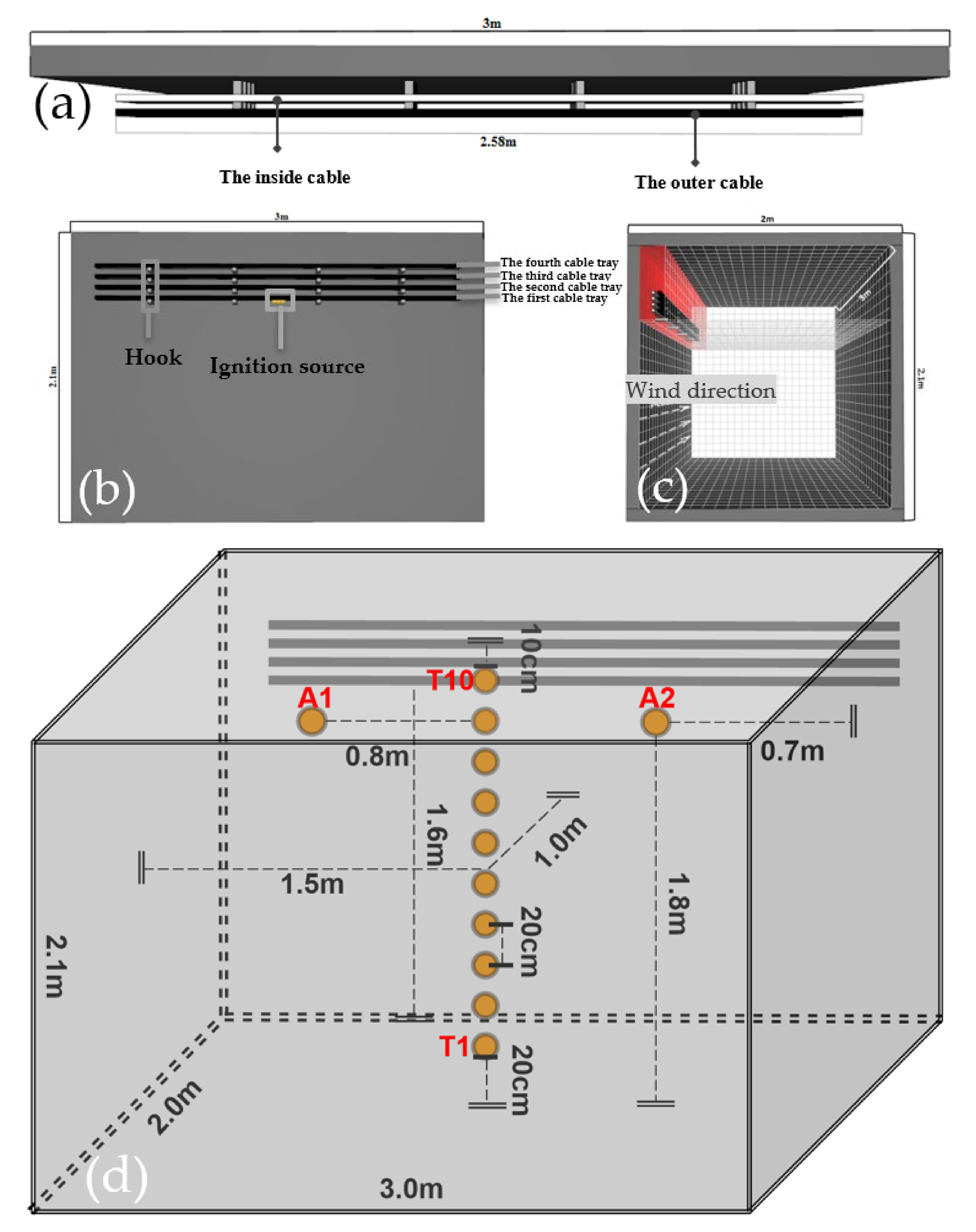
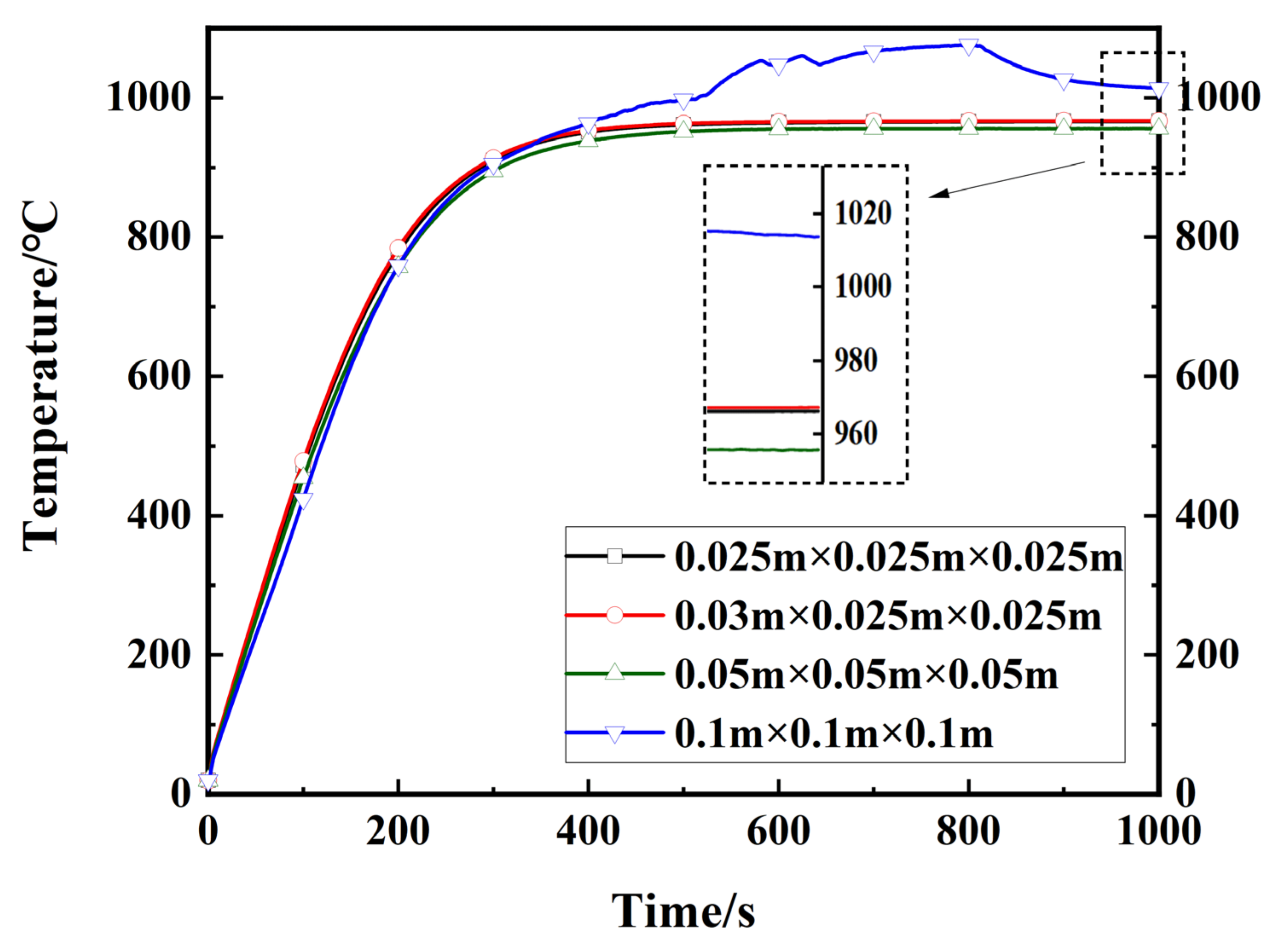

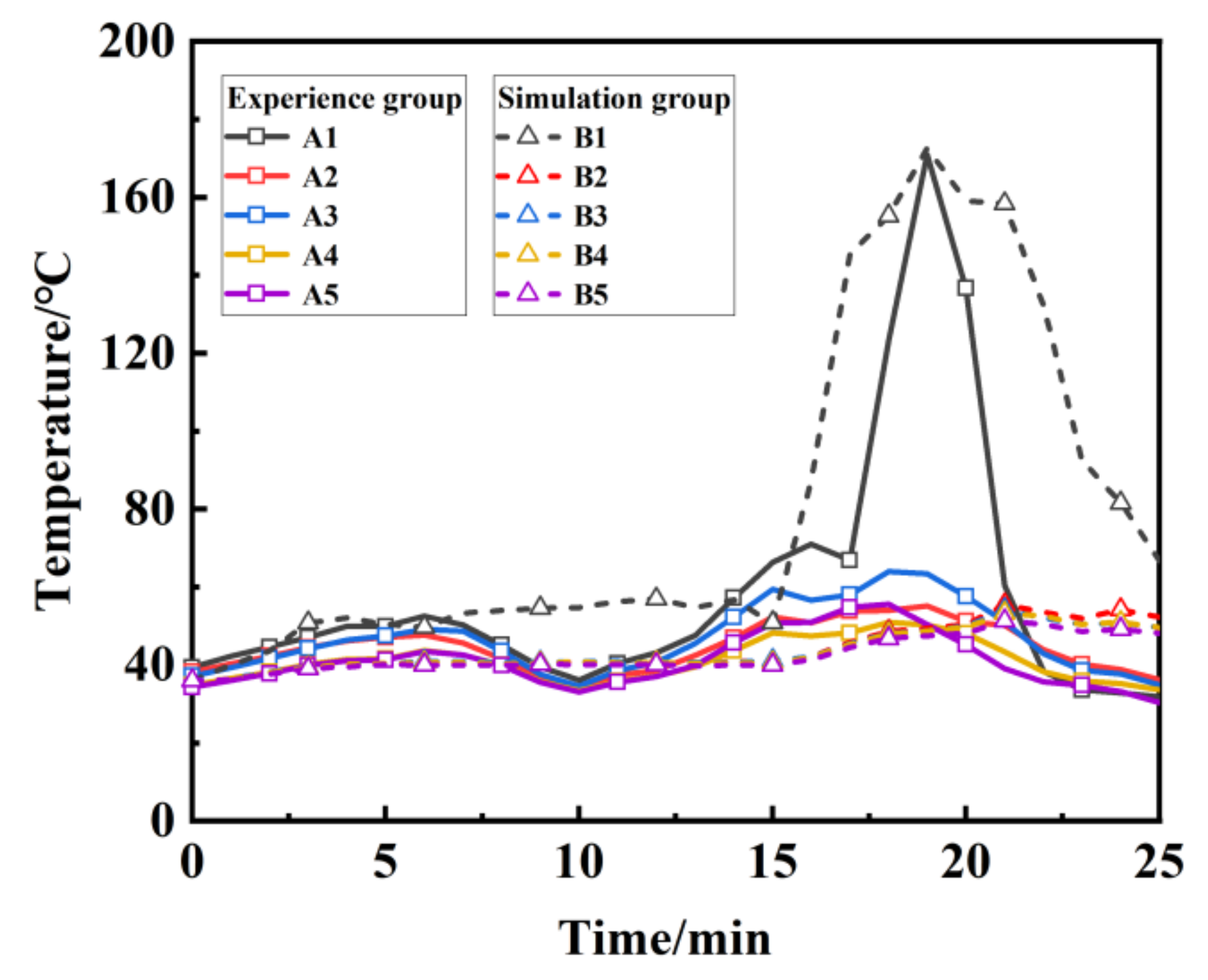
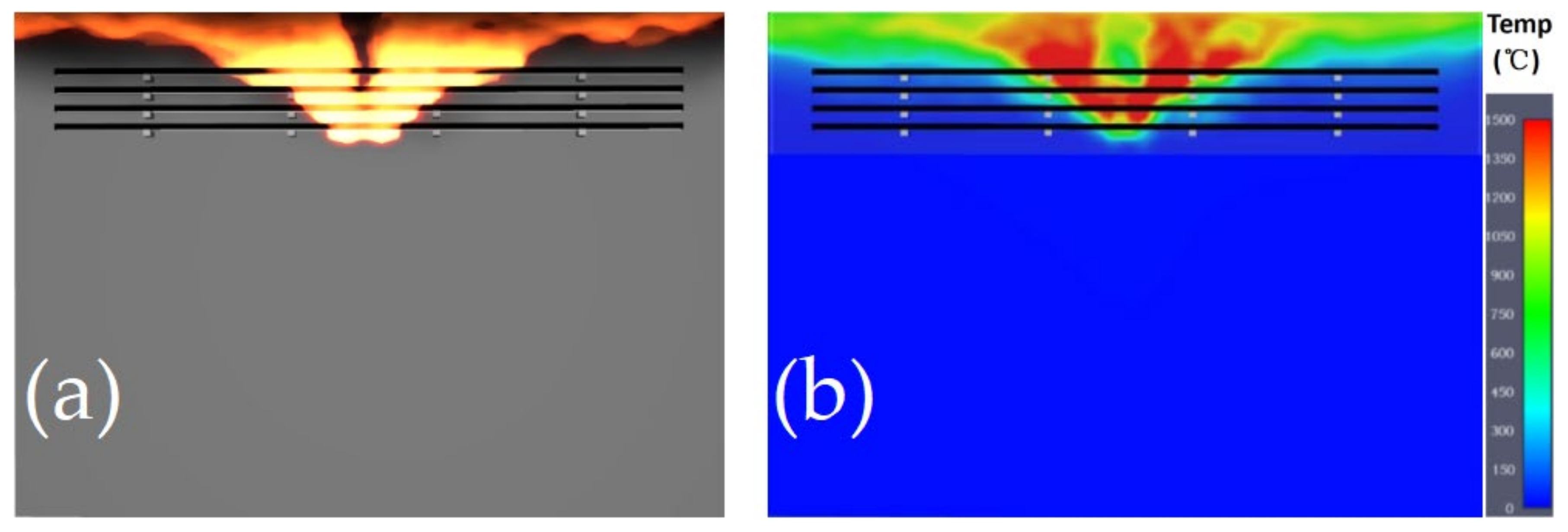
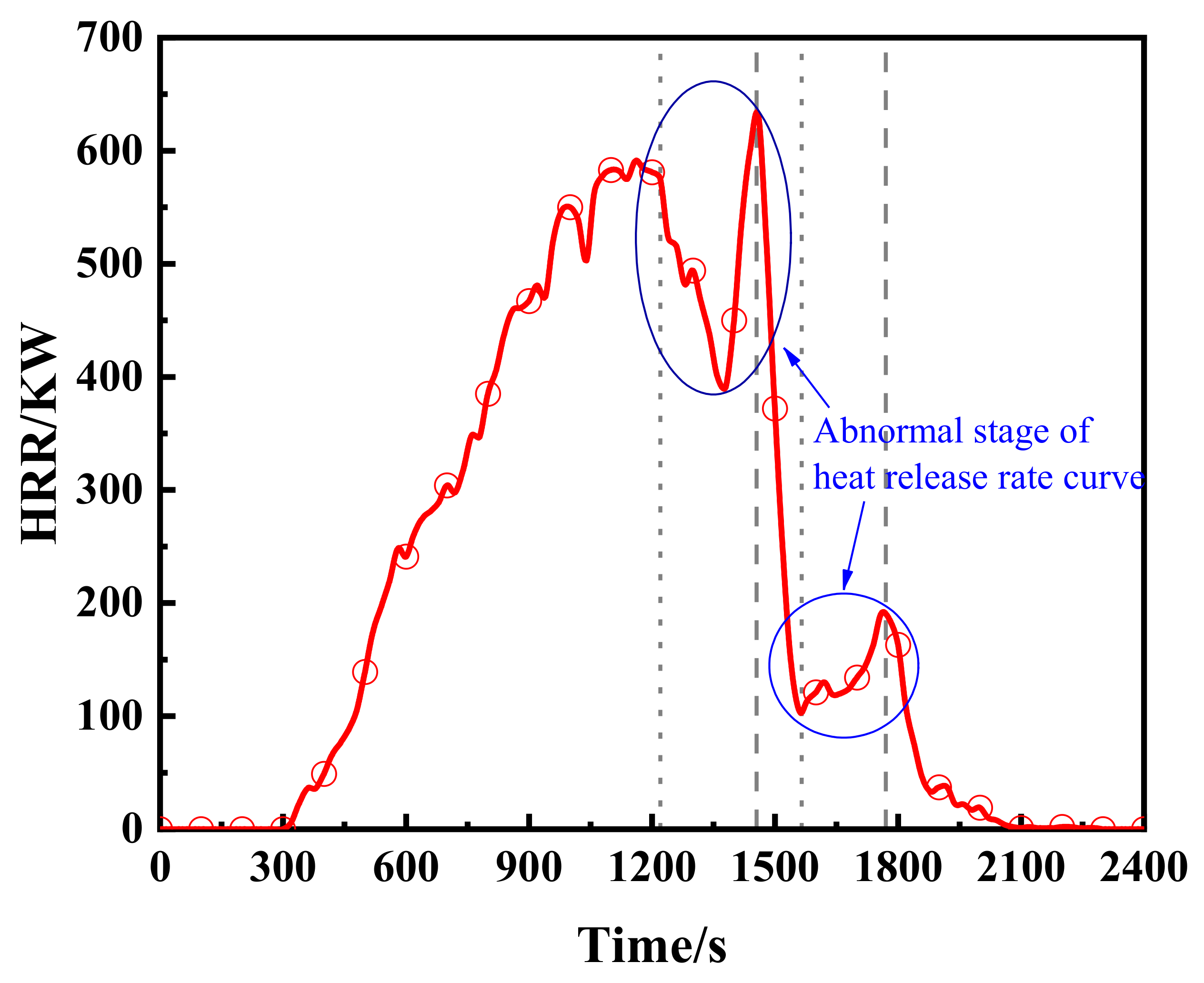
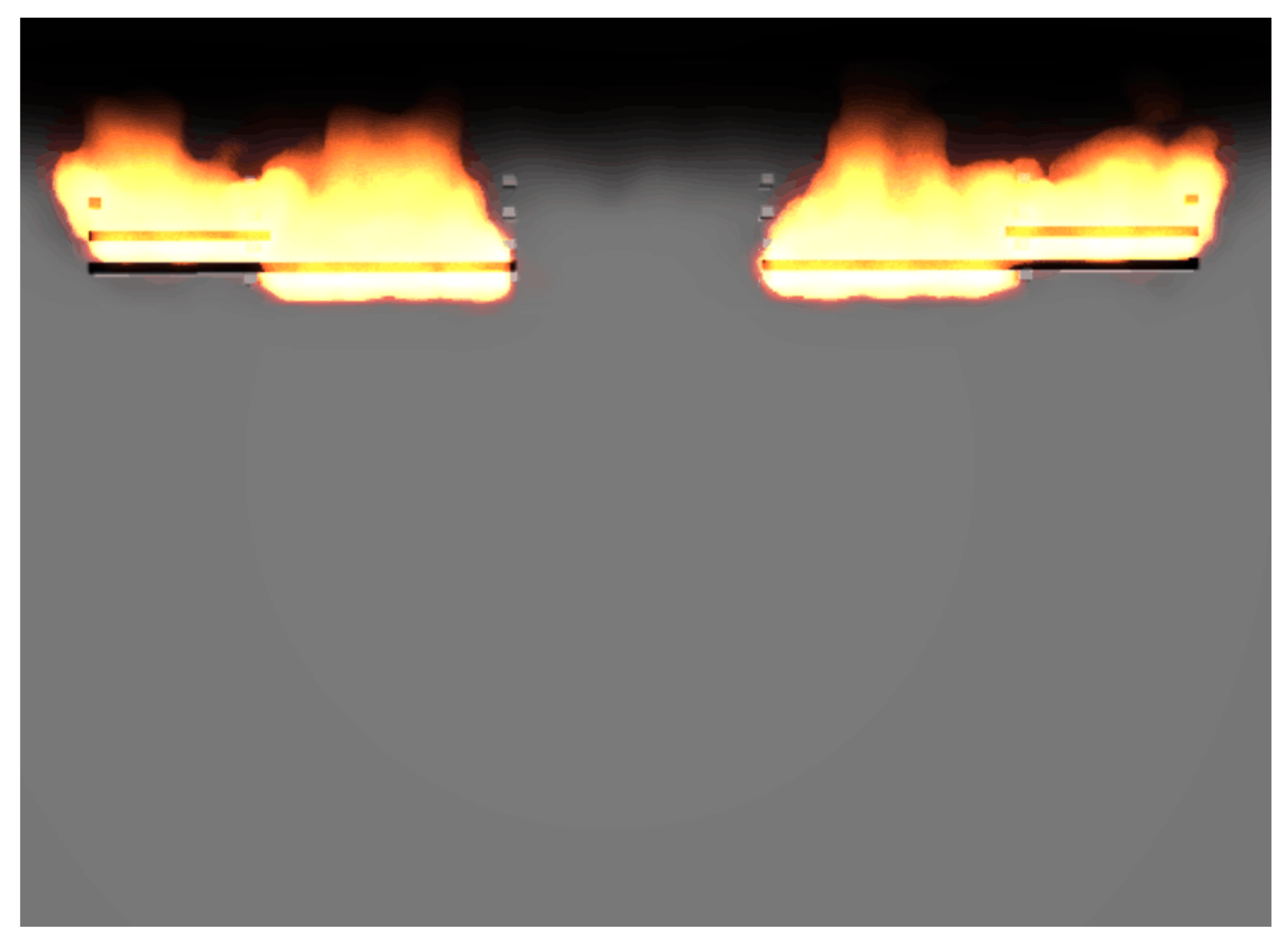
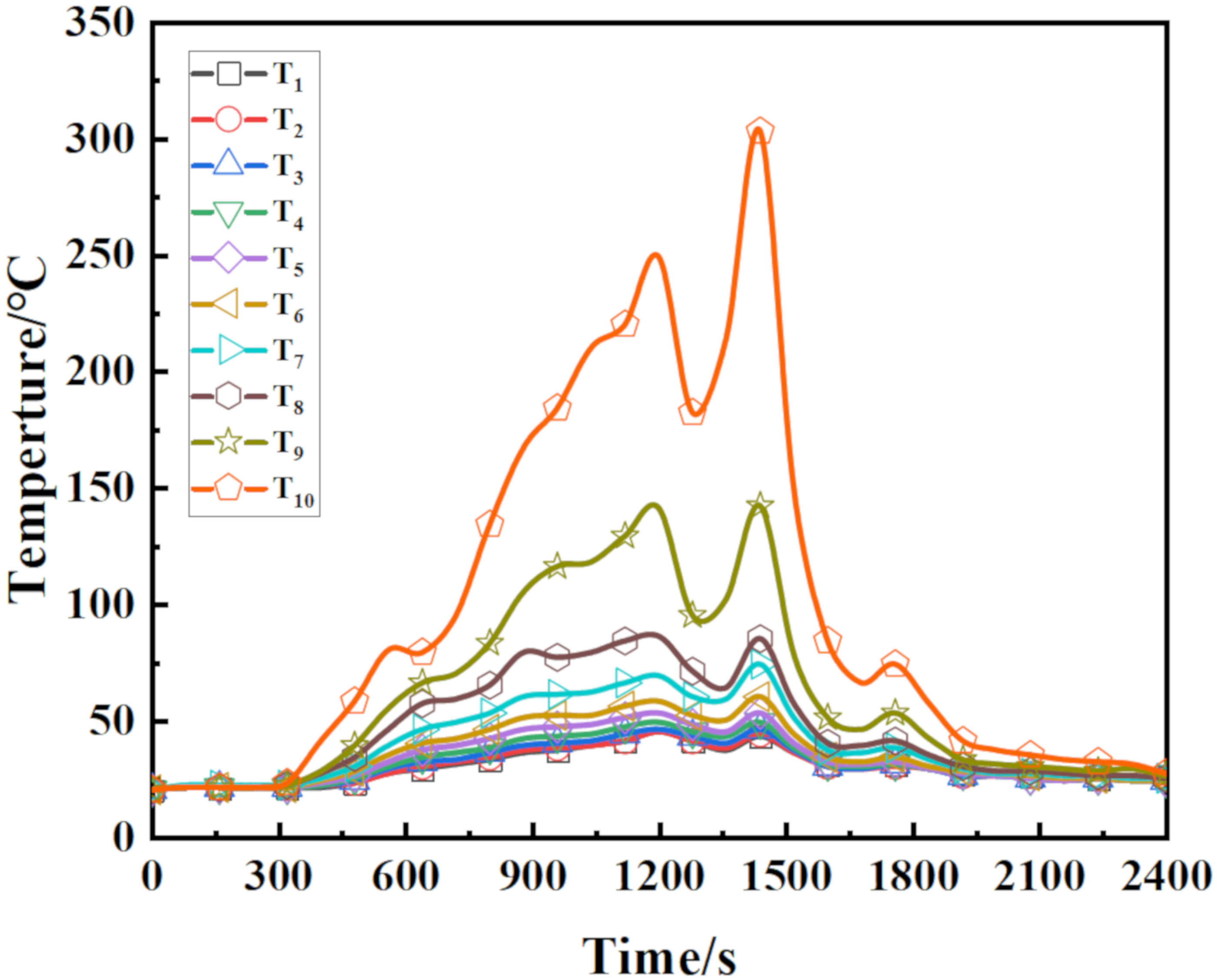
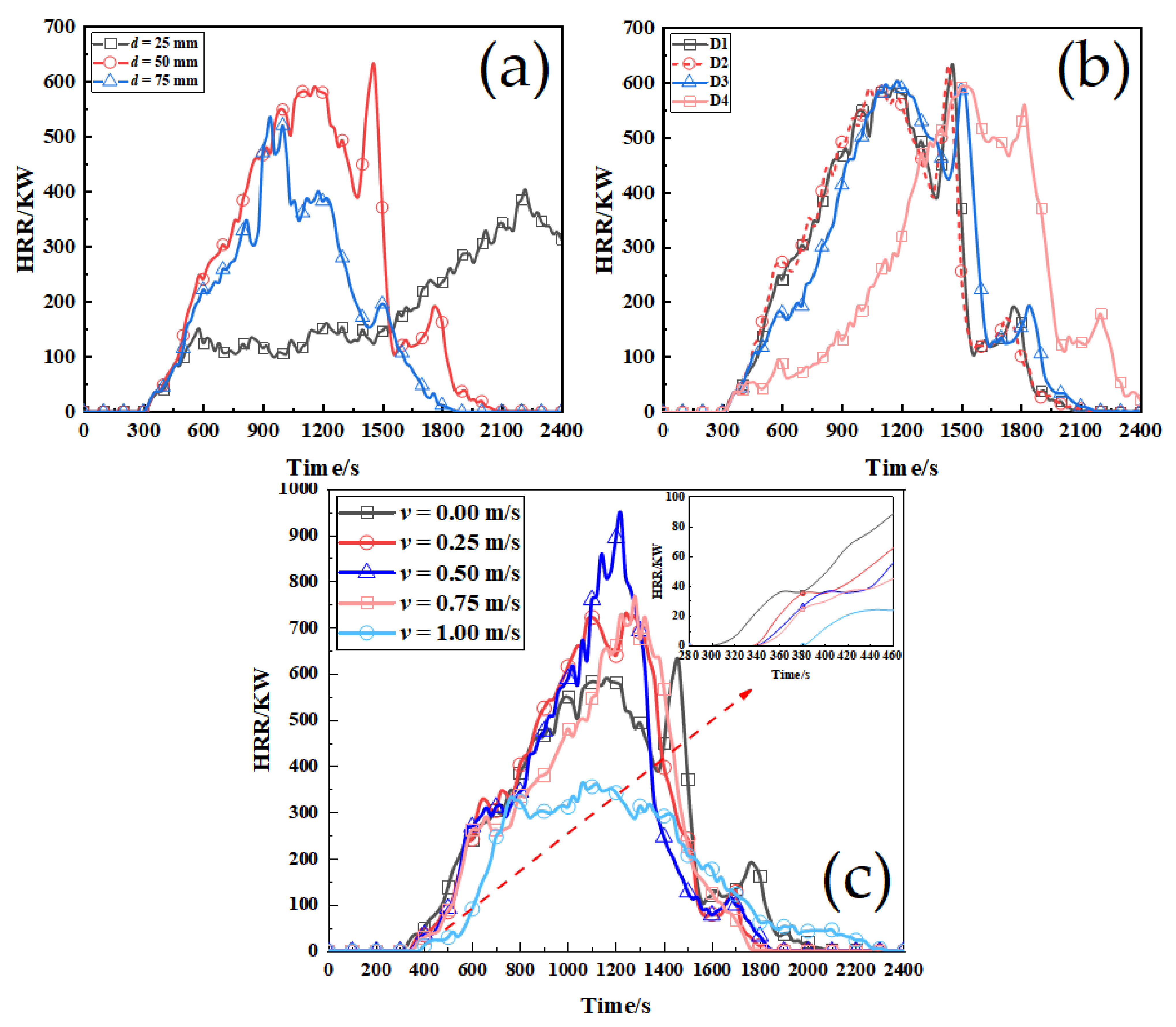
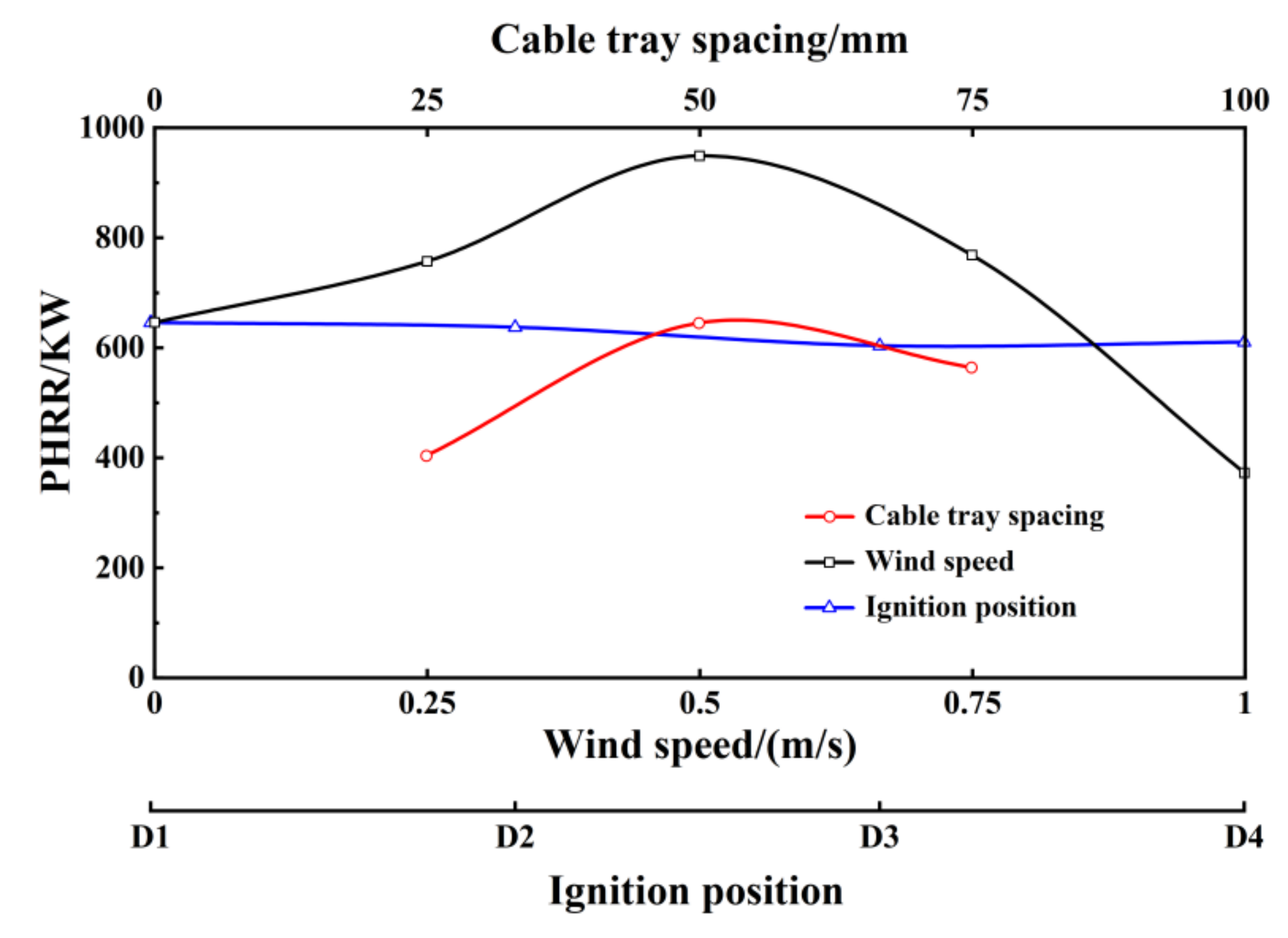
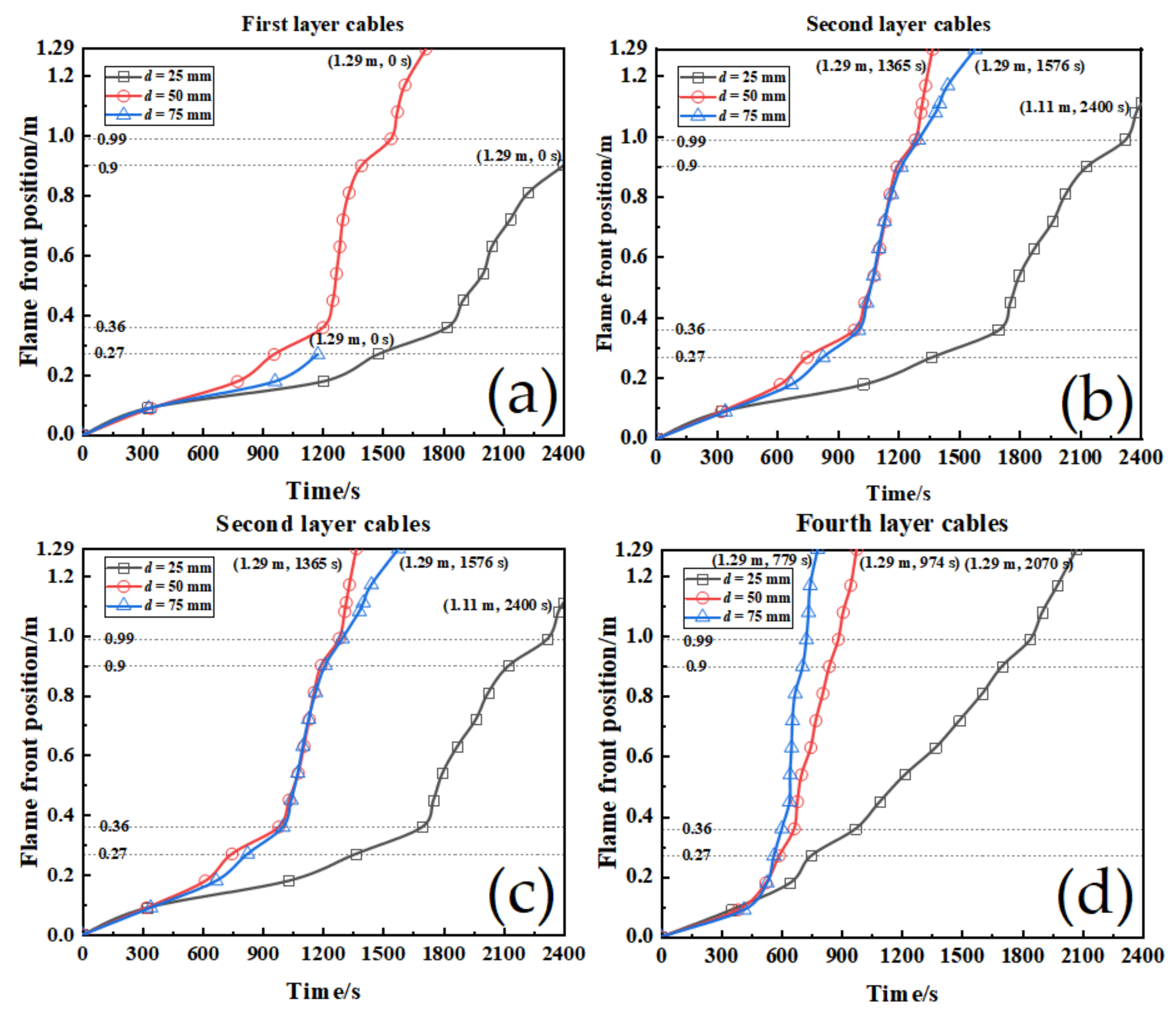
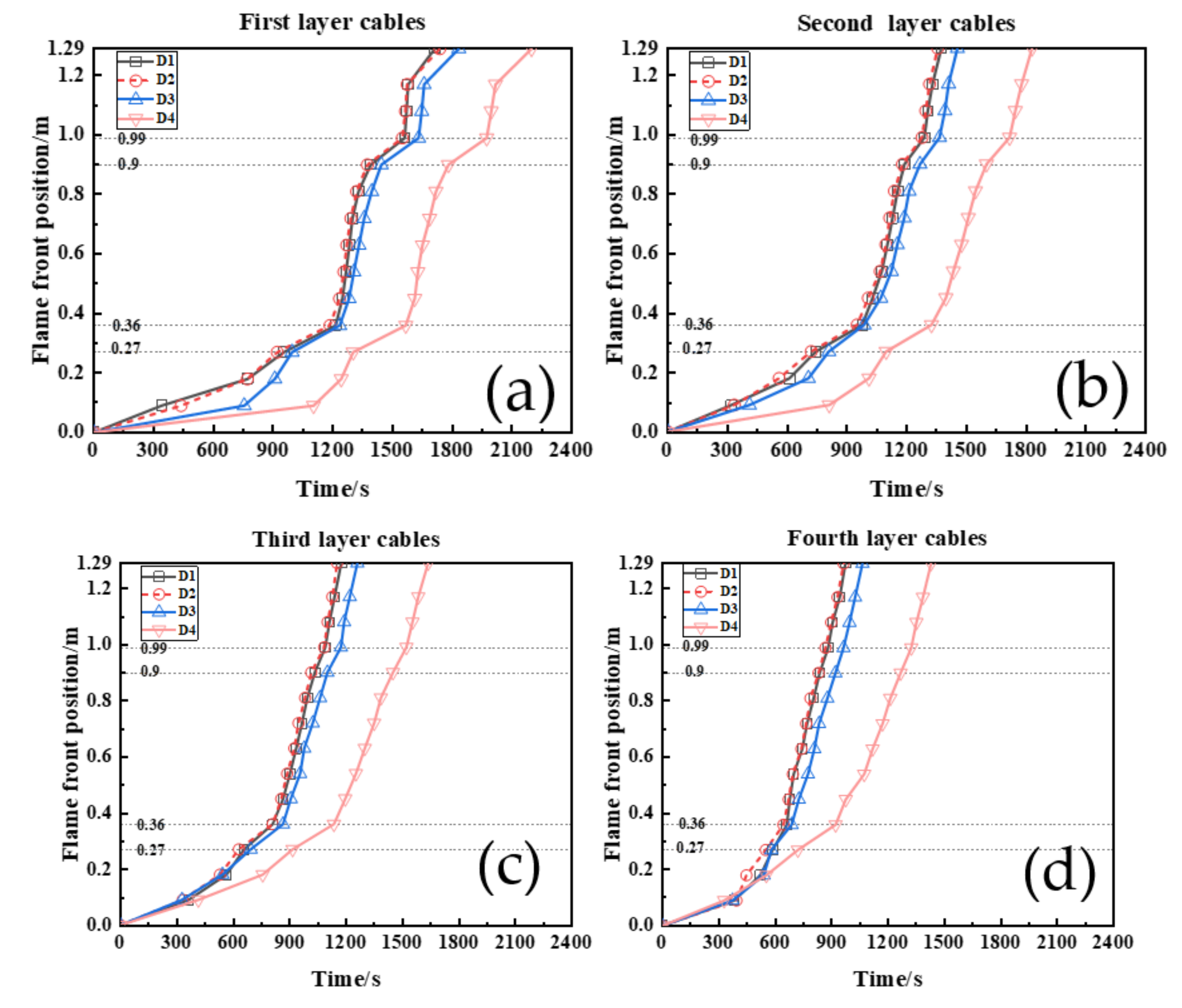


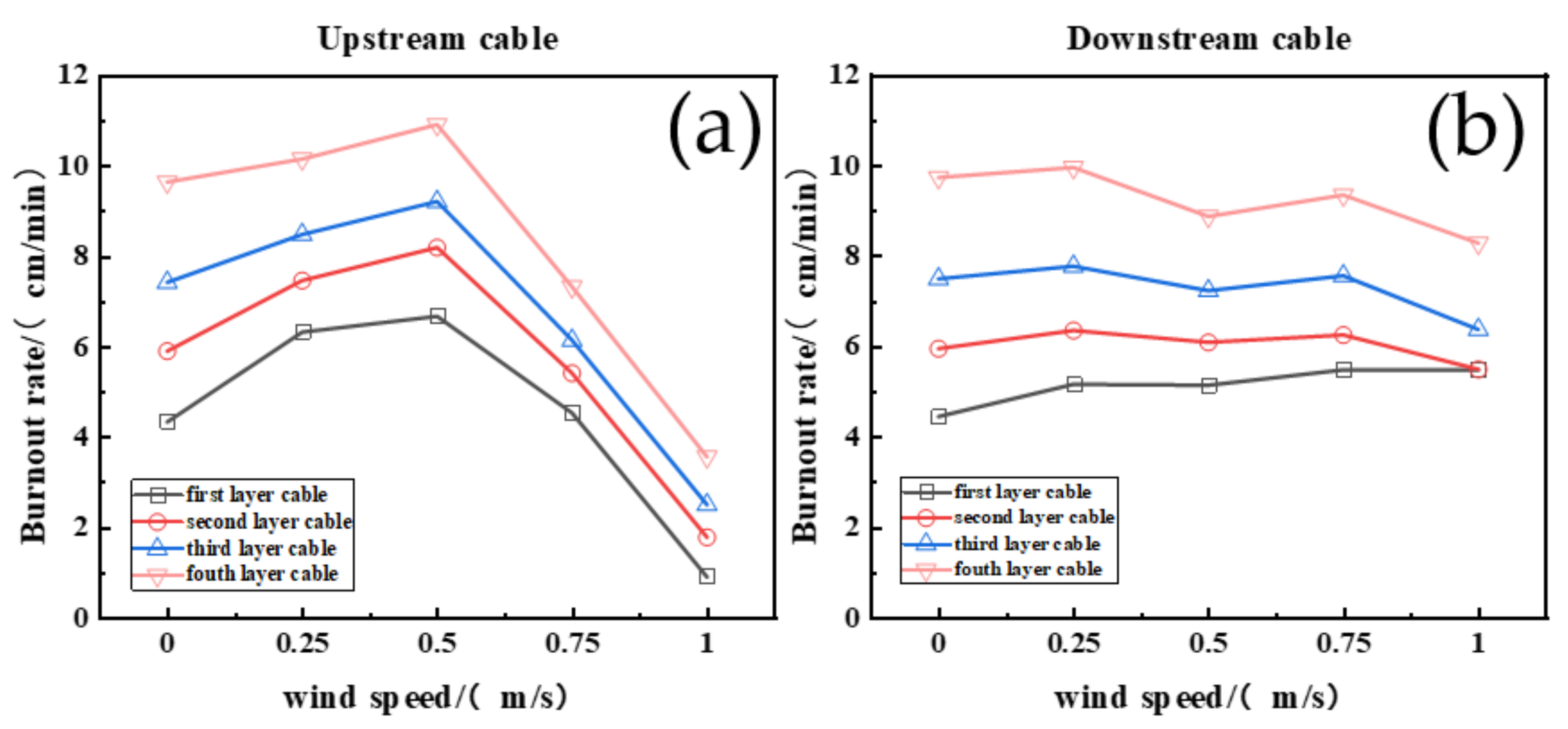
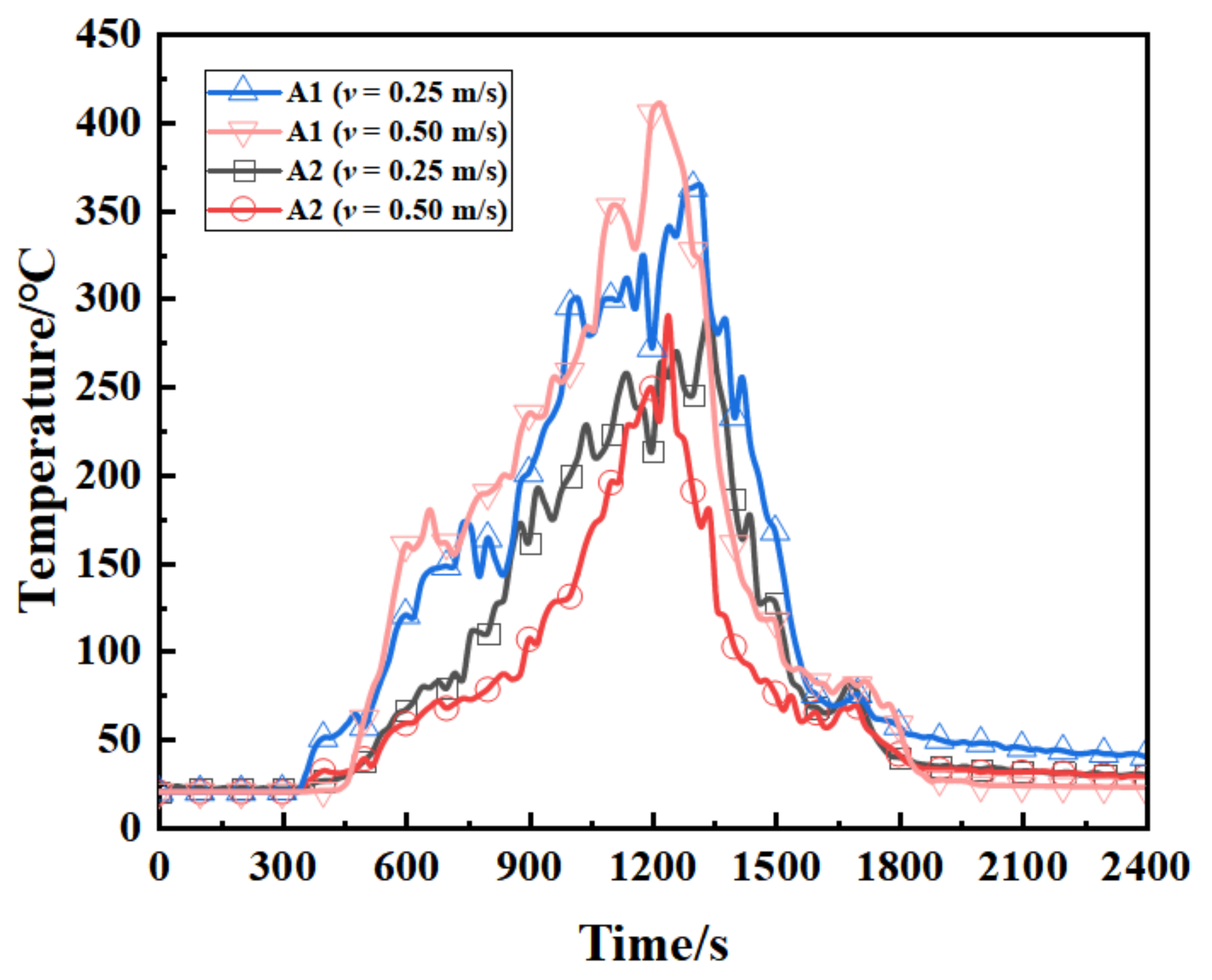
| Materials | Density [kg/m³] | Specific Heat Capacity [kJ/(kg·K)] | Heat Conductivity [W/(m·K)] |
|---|---|---|---|
| PVC | 1380 | 1.28 | 0.2 |
| Copper | 8940 | 0.38 | 387 |
| Parameter | Meaning | Values |
|---|---|---|
| Heat release rate [KW] | 100 | |
| Air density [kg/m3] | 1.2 | |
| Air specific heat [kJ/(kg · K)] | 1 | |
| Environment temperature [K] | 293.15 | |
| Acceleration of gravity [m/s2] | 9.8 |
| Condition Number | Cable Tray Spacing [mm] | Ventilation Speed [m/s] | Ignition Position |
|---|---|---|---|
| 1 | 25 | 0 | Under the first cable tray |
| 2 | 50 | 0 | Under the first cable tray |
| 3 | 75 | 0 | Under the first cable tray |
| 4 | 50 | 0.25 | Under the first cable tray |
| 5 | 50 | 0.50 | Under the first cable tray |
| 6 | 50 | 1.00 | Under the first cable tray |
| 7 | 50 | 1.50 | Under the first cable tray |
| 8 | 50 | 0 | Under the second cable tray |
| 9 | 50 | 0 | Under the third cable tray |
| 10 | 50 | 0 | Under the fourth cable tray |
| First Layer of Cable | Second Layer of Cable | Third Layer of Cable | Fourth Layer of Cable | |
|---|---|---|---|---|
| The left side of ignition position | 0.056 m/min | 0.065 m/min | 0.078 m/min | 0.084 m/min |
| The right side of ignition position | 0.056 m/min | 0.064 m/min | 0.077 m/min | 0.085 m/min |
| First Layer Cable | Second Layer Cable | Third Layer Cable | Fourth Layer Cable | |
|---|---|---|---|---|
| D1 | 303 s | 320 s | 340 s | 374 s |
| D2 | 391 s | 303 s | 320 s | 340 s |
| D3 | 702 s | 389 s | 303 s | 320 s |
| D4 | 1080 s | 768 s | 392 s | 303 s |
| 0.00 m/s | 0.25 m/s | 0.50 m/s | 0.75 m/s | 1.00 m/s | |
|---|---|---|---|---|---|
| The time of cable combustion initiation | 303 s | 334 s | 342 s | 344 s | 380 s |
Publisher’s Note: MDPI stays neutral with regard to jurisdictional claims in published maps and institutional affiliations. |
© 2022 by the authors. Licensee MDPI, Basel, Switzerland. This article is an open access article distributed under the terms and conditions of the Creative Commons Attribution (CC BY) license (https://creativecommons.org/licenses/by/4.0/).
Share and Cite
Tang, Z.; Gao, K.; Shan, Y.; Zhu, C.; Liu, Z.; Liu, Z. Study of the Fire Behavior of Multilayer Cables in a Mine Tunnel. Energies 2022, 15, 2059. https://doi.org/10.3390/en15062059
Tang Z, Gao K, Shan Y, Zhu C, Liu Z, Liu Z. Study of the Fire Behavior of Multilayer Cables in a Mine Tunnel. Energies. 2022; 15(6):2059. https://doi.org/10.3390/en15062059
Chicago/Turabian StyleTang, Zhiqiang, Ke Gao, Yafei Shan, Chengyao Zhu, Zeyi Liu, and Zimeng Liu. 2022. "Study of the Fire Behavior of Multilayer Cables in a Mine Tunnel" Energies 15, no. 6: 2059. https://doi.org/10.3390/en15062059
APA StyleTang, Z., Gao, K., Shan, Y., Zhu, C., Liu, Z., & Liu, Z. (2022). Study of the Fire Behavior of Multilayer Cables in a Mine Tunnel. Energies, 15(6), 2059. https://doi.org/10.3390/en15062059







